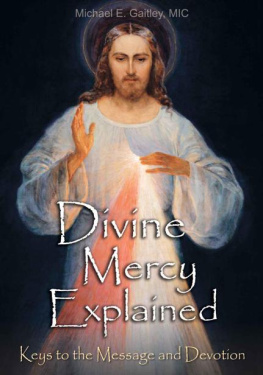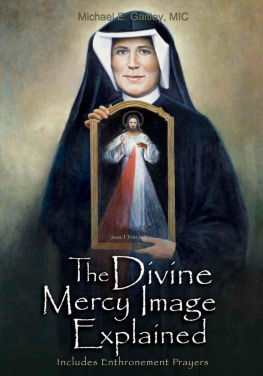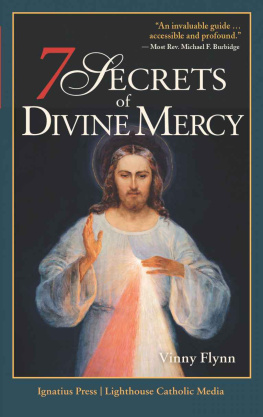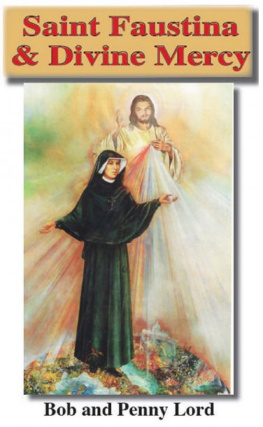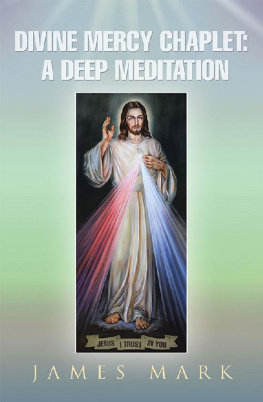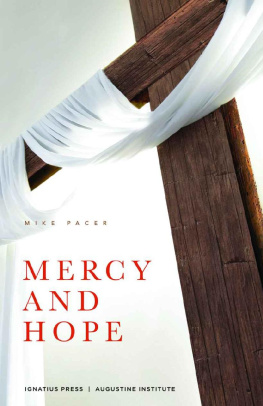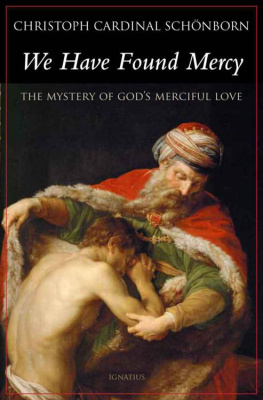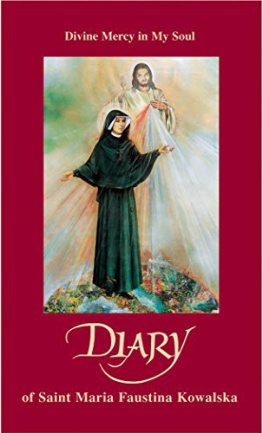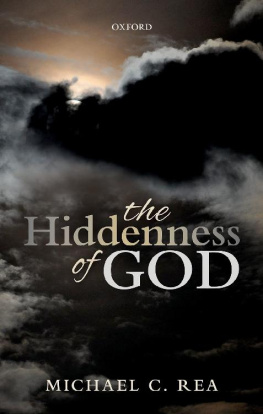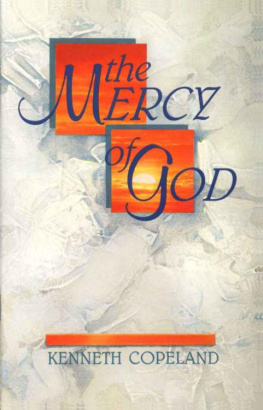Michael E. Gaitley - Divine Mercy Explained
Here you can read online Michael E. Gaitley - Divine Mercy Explained full text of the book (entire story) in english for free. Download pdf and epub, get meaning, cover and reviews about this ebook. year: 2013, publisher: Marian Press, genre: Religion. Description of the work, (preface) as well as reviews are available. Best literature library LitArk.com created for fans of good reading and offers a wide selection of genres:
Romance novel
Science fiction
Adventure
Detective
Science
History
Home and family
Prose
Art
Politics
Computer
Non-fiction
Religion
Business
Children
Humor
Choose a favorite category and find really read worthwhile books. Enjoy immersion in the world of imagination, feel the emotions of the characters or learn something new for yourself, make an fascinating discovery.
- Book:Divine Mercy Explained
- Author:
- Publisher:Marian Press
- Genre:
- Year:2013
- Rating:4 / 5
- Favourites:Add to favourites
- Your mark:
- 80
- 1
- 2
- 3
- 4
- 5
Divine Mercy Explained: summary, description and annotation
We offer to read an annotation, description, summary or preface (depends on what the author of the book "Divine Mercy Explained" wrote himself). If you haven't found the necessary information about the book — write in the comments, we will try to find it.
Divine Mercy Explained — read online for free the complete book (whole text) full work
Below is the text of the book, divided by pages. System saving the place of the last page read, allows you to conveniently read the book "Divine Mercy Explained" online for free, without having to search again every time where you left off. Put a bookmark, and you can go to the page where you finished reading at any time.
Font size:
Interval:
Bookmark:

Copyright 2013 Marian Fathers of the Immaculate Conception of the B.V.M. All rights reserved.
Available from:
Marian Helpers Center
Stockbridge, MA 01263
Prayerline:1-800-804-3823
Orderline: 1-800-462-7426
Website: www.thedivinemercy.org
ISBN: 978-1-59614-298-5
First edition: 2013
The main text of this work is an excerpt from
The One Thing Is Three by Fr. Michael Gaitley, MIC,
which has received the following:
IMPRIMATUR
Timothy A. McDonnell
Bishop of Springfield, Massachusetts
November 4, 2012
IMPRIMI POTEST
Rev. Kazimierz Chwalek, MIC
Provincial Superior
October 19, 2012
NIHIL OBSTAT
Rev. Mark S. Stelzer, STD
Censor Librorum
October 17, 2012
Text from the English Edition of the Diary of St. Maria Faustina Kowalska: Divine Mercy in My Soul , 1987 Marian Fathers of the Immaculate Conception of the B.V.M., Stockbridge, MA 01263.
I NTRODUCTION
Im writing this booklet to help people fully discover the amazing Divine Mercy message and devotion. And I do mean amazing . Its been called the greatest grassroots movement in the history of the Catholic Church
Perhaps you yourself have already experienced something of this message and devotion. For instance, maybe youve seen the Image of Divine Mercy, which is reproduced on the cover. Or maybe youve prayed the Chaplet of Divine Mercy, which has become popular in so many homes and parishes. Then again, maybe you havent had any experience with it, and youre just curious as to what this Divine Mercy stuff is all about.
Whatever your exposure to the message and devotion, this booklet is for you. Its even for those who have been devoted to Divine Mercy for years. For instance, my friend Vinny Flynn, who has spent several decades in full-time Divine Mercy work, read the rough draft of this manuscript and exclaimed, Finally! A quick, clear, and easy way to understand Divine Mercy! Then, he encouraged me to have it published, and so, here we are.
Now, what exactly is this booklet going to do? Basically, its going to give you a brief and easy-to-understand introduction to Divine Mercy. Specifically, youll learn some of the history and context, all the essential elements of the devotion, and how to live the message. In short, its everything you need to know! Its Divine Mercy explained . Finally, as a bonus, Ive included two helpful appendices: One contains valuable prayers and the other has powerful statements about Divine Mercy from Popes John Paul II and Benedict XVI.
Alright, so lets begin. But before we cover the message and devotion, lets look at Divine Mercy in general.
D IVINE M ERCY IN G ENERAL
Divine Mercy gets to the heart of Sacred Scripture. In fact, as the Catechism of the Catholic Church says, The Gospel is the revelation in Jesus Christ of Gods mercy to sinners.
Okay, so what is Divine Mercy? What is this thing that gets to the heart of Sacred Scripture and to the very center of our faith? To begin, mercy is loves second name. Divine Mercy is when Gods love meets us and helps us in the midst of our suffering and sin. In fact, because this side of eternity were all sinners and because suffering is our lot in life, Gods love for us here always takes the form of mercy. Its always the Lord stepping out in compassion to help us poor, weak, and broken sinners. From our perspective, then, every good we receive is an expression Divine Mercy.
T HE M ESSAGE OF D IVINE M ERCY
The message of Divine Mercy is something thats most associated with a Polish nun who died in 1938, about a year before the start of World War II. Shes known today as St. Maria Faustina Kowalska. Now, St. Faustina was a mystic. In other words, she received extraordinary experiences of the Lord Jesus in prayer. In fact, Jesus appeared to her and even spoke with her.

Of course, Jesus didnt reveal some new Gospel when he appeared to St. Faustina. I mean, he already revealed everything he needed to say 2,000 years ago to the Apostles and through Sacred Scripture. So, why did he do it? Why did he appear to Faustina? Actually, why does he appear to any mystic for that matter?
God sometimes appears to mystics because he has a prophetic message for a particular time in history, and he uses particular men and women to share his message. Sometimes its to remind us of something thats been forgotten. Sometimes its a warning. At other times, its a message of comfort. Or it may simply be a call to conversion. Whatever it is, it doesnt change the Bible. Rather, it brings us back to it at a certain time in history.
Okay, so whats the particular and important message that God wants to give to us in our modern time through St. Faustina? Simple. He wants to remind us of the heart of Sacred Scripture, namely, his mercy for us sinners. In fact, hes saying to us sinners, Now is the time of mercy. Now is a time of extraordinary mercy! Now is a time when I want give especially great graces to the human race. I want to pour out my mercy in a big way.
Why would God say this? Why would he want to give such great graces in our time? I think Blessed John Paul II explained it best. First, he pointed out something we all know: namely, that there are all kinds of blessings in our contemporary society. For instance, modern technology has done so much to make life easier for us. Just think of e-mail, cell phones, smartphones, and air-conditioning. All these things are blessings. Yet, in the midst of these blessings and in some ways because of the very same advances in technology that brought them, John Paul would say that evil has a reach and power in our day like never before. Indeed, our time, sadly, is marked by unprecedented evil. Despite this, John Paul would also say, Be not afraid. Why should we not be afraid? Because of what St. Paul writes in Romans, Where sin increased, grace abounded all the more (5:20). In other words, God is not outdone by evil. So, in a time of great evil, God wants to give even greater graces, and in our time, the graces are huge , precisely because theres so much sin.
Basically, then, what I want to share in the remainder of this introduction to Divine Mercy, this Divine Mercy explained , is how we can tap into the extraordinary graces of our time. Which makes sense, right? I mean, if there are tons of graces available to us, why not gather them in?
T APPING INTO THE G RACES
Alright, so how do we do it? How do we get the great graces of Divine Mercy in our time? One important way to get them is to live out a devotion to Divine Mercy, and learning how to live it out is easy. All you need to know is one, little word actually, its a little bird: finch. F-I-N-C-H. Finch. If you remember this word, youve got it. But now Ive got to explain it. Okay, so lets get started with F-I-N-C-H , F .
F = Feast. What feast? The Feast of Divine Mercy, also known as Divine Mercy Sunday. Divine Mercy Sunday falls on the Second Sunday of Easter, which is my favorite day of the year. I hope that by the time I finish explaining it, it will be your favorite day also.
Whats so great about Divine Mercy Sunday? Well, look at it this way: Whats the most important feast day of the year? Easter, right? And how many days is Easter? We celebrate it for eight full days, which is why we call it the Octave of Easter. But the last day is the greatest of all. The eighth day. Its the climax of the whole feast. Well, Divine Mercy Sunday is the eighth day of Easter, the climax of the entire Easter celebration. In a sense, its the most important day of the most important feast!
Next pageFont size:
Interval:
Bookmark:
Similar books «Divine Mercy Explained»
Look at similar books to Divine Mercy Explained. We have selected literature similar in name and meaning in the hope of providing readers with more options to find new, interesting, not yet read works.
Discussion, reviews of the book Divine Mercy Explained and just readers' own opinions. Leave your comments, write what you think about the work, its meaning or the main characters. Specify what exactly you liked and what you didn't like, and why you think so.

